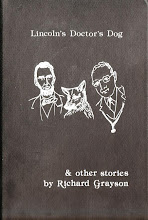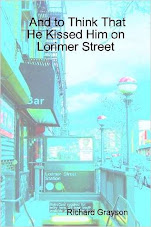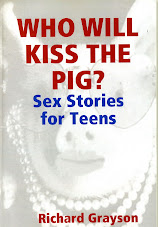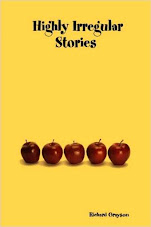
We got to the Second Avenue/Lower East Side subway stop of the F/M lines at 9:45 a.m. on this bright, wintry morning to catch the first of the holiday's vintage subway cars going to Queens Plaza in Long Island City via the Sixth Avenue local stops.

This was the first year we had the schedule in advance (thanks to
Bernard Ente and
Justin Ferate) and were free to get to the premier run of
vintage R-1/9 trains that are running every Sunday from now until Christmas.

You could tell the subway aficionados waiting for 10 a.m. Nearly all of them were middle-aged men, many African-American, and they discussed all kinds of arcane stuff with an insider's knowledge. We overheard an interesting (to us, anyway) discussion of the merits of different combinations of subway and bus routes to get from Manhattan to Starrett City. And we learned that MTA can stand for "More Trouble Ahead" and "Money Thrown Away."

But the cynicism was replaced by excitement as the old train came into the station although some guys complained once it settled in about the front car, which didn't look quite the same as the others. (It was a slightly lighter green but we don't know the specific technical stuff.)

But we're grateful for whatever the MTA spent to let us ride the vintage subway.

It was gorgeous, ran as fast as today's trains though a little bumpier maybe, and yes, the lights flickered.

That was our childhood first impression of the subways -- the flickering lights -- probably gathered from subway cars like the ones we rode on today (it was legal here to move from car to car, just like back in the day).

Our first definite memory of riding the subway was when we were four years old and accompanying our dad to work.

We gripped a little attache case which contained an Archie comic and a Hershey's bar. That ride from Utica Avenue to Union Square on the IRT seemed dark, grown-up, and both thrilling and pretty scary.

What's really scary is that we still say "IRT" in 2010 and get mostly blank looks. Anyway, we rode mostly in cars and buses as a kid -- after 1958, our home was a 20-minute bus ride from the nearest subway stop at best -- and our only other clear memory was when we were nine at our summer bungalow on Beach 56th Street/Place in Rockaway, when our mom's 16-yo cousin Suzi took us to the planetarium. It felt like an expedition, from Beach 60th Street to West 81st Street, and there was a double fare to and from the Rockaways in those days!

We're pretty sure they had these R-1/9 (there were various models starting from the 1940s) when we were a weekday commuter from our house in Old Mill Basin to our tenth grade classes at The Franklin School on West 89th off Central Park West in 1965-66. (New Year's Eve was the start of the massive subway strike and showdown between TWU president Mike Quill and brand-new mayor John Lindsay.)

To get home, we took the CC train from 86th to 59th/Columbus Circle, where we switched to the D (then the Culver Line) to 34th Street, and then we transferred once more, to the Q train to Kings Highway, where we caught the Pioneer Bus Company's Mill Basin bus home. (The Brighton Line wasn't the Q train much longer, but of course it is now and has been for years.) By then the BMT lines had some newer trains without the wicker seats, white fans, and naked light bulbs that these trains had.

Some of the people waiting at the stops today weren't subway buffs but unsuspecting Sunday commuters. One woman seemed very annoyed by the lack of recorded announcements, although the older cars still don't have them today.

In one car, a passenger took it on himself to announce, "Making M train stops to Queens Plaza" and then giving the train's next stop.

The wicker seats seemed oddly raised but were quite comfy.

Mostly there were good-natured subway-system fans, taking photos, inspecting the work of the cars, looking at the vintage ads and signs and maps. One guy had baked cookies for the MTA workers aboard.

It felt like a giddy journey into the past. We remembered that Twilight Zone episode we saw around the time of these subway cars, where the old businessman takes a train to his past in a bucolic hometown.

The signs -- advertisements, announcements, feature -- in all the cars were amazing nostalgia.

We actually remember when "I Am an American Day" was something, although we first learned about it in a Superboy comic book and thought it sounded old-fashioned then. Mayor Wagner was mayor from when we were 2 until we were 14, and when we were little, we thought he'd be mayor forever. We were in the nurse's office at J.H.S. 285 one day for something when we heard his (first) wife died, and everyone was very sad.

Before there was National Public Radio, there was WNYC. Mornings you could catch "About New York" in the days before "Morning Edition" and "The Takeaway."

We certainly didn't know about the fiftieth anniversary of the Fifth Avenue Association in 1957, although maybe our family did, since their Art Pants Company offices were at 95 Fifth Avenue at East 18th Street. The previous year the building's owner offered to sell it to Grandpa Nat for $10,000, but he didn't think it was worth it. (The "place" later moved down the block to 87 Fifth, where it remained until it closed in 1974.) We mostly remember 1957 now as the year the Dodgers left Brooklyn But we do remember that 1958 was International Geophysical Year because a kid couldn't get out of hearing or reading about it. (It was even in a Little Lulu comic, we recall, when she explained that IGY wasn't the character Iggy.)

An announcement that the subway fare would go up to ten cents in 1948. The fare was raised to 15 cents in 1953 and that's the fare we remember paying until we were 15 in 1966 -- after the transit strike. In sympathy, the price of a slice of pizza also jumped to 20 cents.

This announced free Brooklyn subway transfers from the elevated lines to the underground ones on Fulton Street at both Franklin Street and Rockaway Avenue.

Many of the ads seemed so old-fashioned. One had Aunt Jemima selling not her pancakes or syrup but as a kind of celebrity spokeswoman for the NYC Transit Authority urging people to ride subways and buses instead of cars; the ad's purpose seemed to be to "save energy," perhaps during World War II. Here's an ad for Wrigley's twins, Spearmint and Doublemint gum. We remember the Doublemint Twins only as squeaky-clean real-life adolescents.

If Aunt Jemima was advocating "green-friendly" policies regarding transportation, Heinz Ketchup here was touting its being free of "bezoate of soda," which sounds like they were pushing "natural foods" way back when. All we knew was that Heinz Ketchup went on our burgers, french fries, scrambled eggs and was especially delicious on spaghetti with melting Breakstone salty butter.

Grape Nuts used to be popular, too, although we thought it tasted like rocks.

New York City was a 24-hour town in the days before 24/7, back when men were told to use Burma Shave and not be litterbugs. This anti-littering ad predated Phil D. Basket.

Last stop, Queens Plaza.

We watched the nostalgia train as it went off to get ready for its ride back from Queens to the Lower East Side, but decided against a return voyage.

Since the G train wasn't running this weekend (is it ever running normally on the weekend? of course they're improving the system all the time, right?), we exited and at the corner of Queens Boulevard and Jackson Avenue, we got a quick shuttle bus back to Williamsburg

and were home an hour after we got on the subway to our childhood and adolescence.









































































































